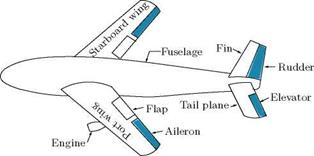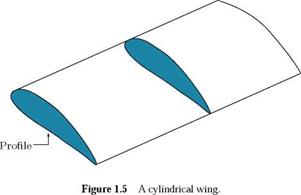Monoplane Aircraft
A monoplane is a fixed-wing aircraft with one main set of wing surfaces, in contrast to a biplane or triplane. Since the late 1930s it has been the most common form for a fixed wing aircraft.
The main features of a monoplane aircraft are shown in Figure 1.3. The main lifting system consists of two wings, the port (left) and starboard (right) wings, which together constitute the aerofoil. The tail plane also exerts lift. According to the design, the aerofoil may or may not be interrupted by the fuselage. The designer subsequently allow for the effect of the fuselage as a perturbation (a French word which means disturbance) of the properties of the aerofoil. For the present discussion, let us ignore the fuselage, and treat the wing (aerofoil) as one continuous surface.
The ailerons on the right and left wings, the elevators on the horizontal tail, and the rudder on the vertical tail, shown in Figure 1.3, are control surfaces. When the ailerons and rudder are in their neutral positions, the aircraft has a median plane of symmetry which divides the whole aircraft into two parts, each of which is the optical image of the other in this plane, considered as a mirror. The wings are then the portions of the aerofoil on either side of the plane of symmetry, as shown in Figure 1.4.
 |
|
 |
|
The wing tips consist of those points of the wings, which are at the farthest distance from the plane of symmetry, as illustrated in Figure 1.4. Thus, the wing tips can be a point or a line or an area, according to the design of the aerofoil. The distance between the wing tips is called the span. The section of a wing by a plane parallel to the plane of symmetry is called a profile. The shape and general orientation of the profile will usually depend on its distance from the plane of symmetry. In the case of a cylindrical wing, shown in Figure 1.5, the profiles are the same at every location along the span.
|
|
|
Figure 1.4 Typical geometry of an aircraft wing.
|
1.1.1 Types of Monoplane
The main distinction between types of monoplane is where the wings attach to the fuselage:
Low-wing, the wing lower surface is level with (or below) the bottom of the fuselage.
Mid-wing, the wing is mounted mid-way up the fuselage.
High-wing, the wing upper surface is level with or above the top of the fuselage.
Shoulder wing, the wing is mounted above the fuselage middle.
Parasol-wing, the wing is located above the fuselage and is not directly connected to it, structural support being typically provided by a system of struts, and, especially in the case of older aircraft, wire bracing.













